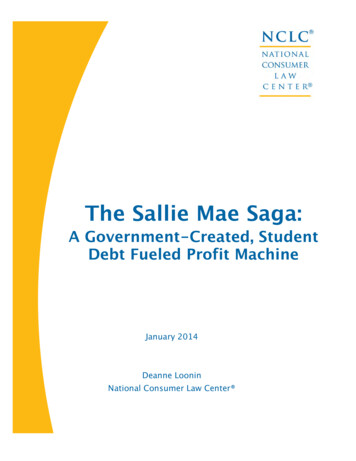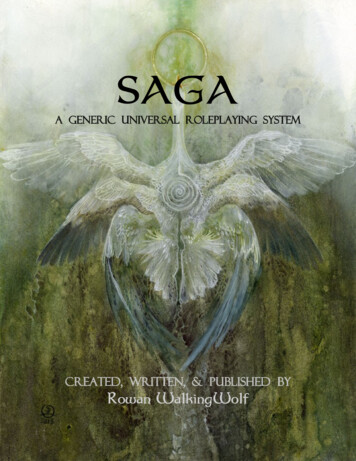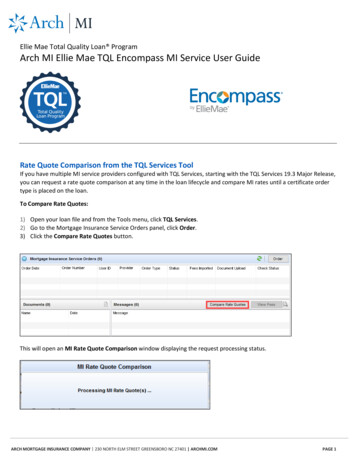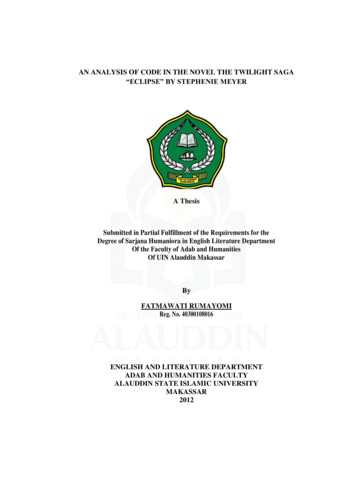
Transcription
WhyThe Sallie Mae Saga:A Government-Created, StudentDebt Fueled Profit MachineJanuary 2014Deanne LooninNational Consumer Law Center
Copyright 2014, National Consumer Law Center, Inc. All rights reserved.ABOUT THE AUTHORDeanne Loonin is an attorney with the National Consumer Law Center (NCLC) and theDirector of NCLC’s Student Loan Borrower Assistance Project. Deanne assists attorneysrepresenting low-income consumers, and teaches consumer law to legal services, privateconsumer attorneys, and other advocates. Deanne is the co-author of NCLC’s publicationsStudent Loan Law and Guide to Surviving Debt as well as numerous reports on the studentloan industry and borrower issues. Prior to joining NCLC in 1997, Deanne worked as a legalaid attorney in Los Angeles. She is a member of the California and Massachusetts bars.ACKNOWLEDGEMENTSThis report is a release of the National Consumer Law Center’s Student Loan BorrowerAssistance Project. NCLC research assistant Marina Levy provided extensive researchand editorial content. The author thanks NCLC colleagues Carolyn Carter, Jan Kruse,Robyn Smith and Persis Yu for valuable comments and assistance. We also thank NCLCcolleague Beverlie Sopiep for layout assistance.The findings and conclusions presented in this report are those of the authors alone.NCLC’s Student Loan Borrower Assistance Project provides informationabout student loan rights and responsibilities for borrowers and advocates.We also seek to increase public understanding of student lending issuesand to identify policy solutions to promote access to education, lessenstudent debt burdens, and make loan repayment more OUT THE NATIONAL CONSUMER LAW CENTERSince 1969, the nonprofit National Consumer Law Center (NCLC ) has used its expertise inconsumer law and energy policy to work for consumer justice and economic security for lowincome and other disadvantaged people, including older adults, in the United States. NCLC’sexpertise includes policy analysis and advocacy; consumer law and energy publications; litigation;expert witness services, and training and advice for advocates. NCLC works with nonprofit andlegal services organizations, private attorneys, policymakers, and federal and state governmentand courts across the nation to stop exploitive practices, help financially stressed families buildand retain wealth, and advance economic fairness.www.nclc.org
TABLE OF CONTENTSI.INTRODUCTION. 1II.SALLIE MAE’S PRIVATE STUDENT LENDING AND THE HARM TOBORROWERS . 5III.SALLIE MAE AS GOVERNMENT SERVICER . 10IV.RECOMMENDATIONS. 15A.B.C.D.Federal and State Government Agencies Must Coordinate and Engage in RigorousOversight and Enforcement . 15Improve Evaluation of Servicers and Collectors . 15Hold Servicers and Collectors Accountable for Poor Performance andLegal Violations . 15Recommended Actions for Private Student Loans . 16Endnotes .24Appendix A .16Appendix B .24GraphicsTimeline: Sallie Mae through the Years (1972 – 2013) .3Sallie Mae’s Net Income (2010 – 2013Q3) .4Chart: Private Education Loan Industry Originations 5Chart: Growth in Student Loans Asset Backed Securities .5Table: Sallie Mae’s Defaults and Delinquencies. 6Chart: Lobbying Expenditures by Sallie Mae (2008-2012) .10Table: Federal Loan Servicer Payments as of September 30, 2011. .10Table: U.S. Department of Education Servicer Rank by Metric (2012-2013) .11Table: U.S. Department of Education Fifth Year Allocations for Servicers 11
I.INTRODUCTIONStudent loan debt levels keep growing. There are nearly 39 million borrowers carrying over 11trillion in federal student loan debt. About 120 billion of federal student loan debt was2delinquent in 2012--a 30.5% increase from fiscal year 2011.Most borrowers fall behind on student loan payments because they are unable to complete theireducations, suffer from serious disabilities, or earn so little money that they cannot afford torepay their loans. The stakes are high for borrowers due to draconian government collectionpowers, including seizure of earned income tax credits and Social Security payments. Eventhose who can make some payments face serious damage to their credit reports or ability to getcredit for critical purchases such as cars and homes.The burdens on borrowers also create once in a lifetime business opportunities for servicers,collectors, and other private companies:“The student loan market is a 1 trillion opportunity for the ARM [debt collection] industry thatis not going to decline anytime soon.”-- Mark Russell, “Student Loans: The ARM Industry’s New OilWell?” Inside ARM (Oct. 20, 2011).Sallie Mae is the biggest player of all, with connections to every aspect of the student loanindustry. President Nixon created the Student Loan Marketing Association, or “Sallie Mae” —a government-sponsored enterprise (GSE) empowered by the government to use U.S. Treasurymoney to buy government-backed student loans from banks. The motivation was to free upfunds for the banks to make more loans.Sallie Mae benefited for many years from its close government connections. In a September2013 letter (see Appendix A) to the U.S. Departments of Treasury and Education, SenatorElizabeth Warren summarizes these benefits, including: The Sallie Mae SagaGovernment contracts worth hundreds of millions of dollars,Indirect and direct benefits, including Sallie Mae’s borrowing of billionsof dollars at “astonishingly” low interest rates through the federallybacked Federal Home Loan Bank of Des Moines,Reaping profits of 284 million in 2009 and 321 million in 2010 by sellinggovernment-guaranteed loans to the federal government, andBenefiting from an asset-backed commercial paper conduit facilitythrough which the company borrowed billions at the very low rate of30.82%.1
Sallie Mae ultimately became a fully private company in 2004, growing into the dominant forcein the student loan world. The time line below shows how the company, once it was fullyprivatized, started buying competitors and others in the student lending, servicing, andcollection industries.The business has been extraordinarily profitable. For example, Sallie Mae’s return on equity was4over 30% in 2006, one of the highest among American companies. Their executives reaped the5rewards. From 1999 through 2004, former CEO Albert Lord took home over 200 million.The federal government has chosen to rely on private companies such as Sallie Mae toadminister its loan programs. Given a for-profit company’s imperative to do what is best for itsinvestors, it is especially critical that the government conduct rigorous oversight of its privatecontractors. Unfortunately, the growing number of government investigations and consumercomplaints show that government supervision has been lax at best.This report starts by spotlighting the mammoth company known as Sallie Mae. This analysisprovides insight into the dangers of relying on a for-profit publicly traded company to protectborrowers and taxpayers. We conclude with recommendations for reform.The Sallie Mae Saga2
Sallie Mae through the Years (1972-2013)1972Congress creates Sallie Mae to provide a“secondary market” for student loans. As agovernment sponsored enterprise (GSE), thecompany is able to borrow at very low rates.1979 - 1988Sallie Mae’s assets grow from 1.6 billion to 28.6 billion.1980Congress strengthens Sallie Mae, authorizingthe company to offer loan consolidation andto make loans directly to certain students.1993Creation of new government Direct Loanprogram threatens Sallie Mae’s market status.Sallie Mae wins approval to abandon GSEstatus and become a fully private company(which it ultimately did in 2004).1996Allowed to pursue business opportunitiesoutside the limits of the GSE charter. SLMHolding Corporation becomes the parentcompany of both a GSE entity known as theStudent Loan Marketing Association and anon-GSE corporation, Sallie Mae.Since the USA Group acquisition, SallieMae has purchased numerous other debtmanagement and collection companies,including General RevenueCorporation, Pioneer Credit Recovery,Arrow Financial Services and GRPFinancial Services Corporation.2003Acquires the Massachusetts-based AcademicManagement Services Corporation, addingabout 1.4 billion in student loans.2004 The GSE entity ends operations. Acquires Southwest Student ServicesCorporation and the nonprofit lender,Student Loan Finance Association.2005Establishes the Sallie Mae Bank as anindustrial bank chartered under the laws ofthe state of Utah.1999Purchases loan originator Nellie Mae.2000 Acquires USA Group, the largest guarantyagency in the country for 770 million. (Thepurchase did not include USA Funds, theguarantee agency arm of USA Group, butSallie Mae required USA Funds to contractall of its guarantee services to Sallie Mae aspart of the deal6).The Sallie Mae Saga2000 (continued) Also purchases Student Loan FundingResources, the eighth largest holder offederal student loans at the time.32006Acquires Upromise Inc. and its subsidiaries,Upromise Investments and UpromiseInvestment Advisors2007Agrees to stop offering perks to collegeemployees and others as part of asettlement with the New York AttorneyGeneral. As part of the settlement,Sallie Mae pays 2 million into a fund toeducate students and parents.
Sallie Mae Timeline (continued)2009 Named as a servicer of newly disbursedDepartment of Education federal loans.2013 Announces proposed split into two publiclytraded companies- NewCo and Sallie MaeBank. NewCo will serve as the educationloan-management business and will containabout 95% of Sallie Mae’s assets including 118.1 billion in federal loans and 31.6billion of private loans.8 Department of Education Inspector FDIC announces plans to replace an2008FDIC and Utah Dept. of FinancialInstitutions issue cease and desist orderagainst Sallie Mae Bank.General Audit Report finds that SallieMae improperly obtained 22.3 millionin excess student loan subsidies fromthe government between 2003 and2006.existing cease and desist order with anew formal enforcement action basedon alleged violations of the FederalTrade Commission Act, theServicemembers Civil Relief Act, andthe Equal Credit Opportunity Act.2009 - 2010 Department of Education InspectorBooked profits of 284 million in 2009and 321 million in 2010 by sellinggovernment-guaranteed loans to thefederal government.7General cites problems with SallieMae subsidiary Pioneer Collection,focusing on failures to report verbalcomplaints received from borrowers.2012 Settles class action filed by investors Reveals that the company is also underalleging that Sallie Mae loweredlending standards to bolster itsportfolio of subprime private studentloans and then tried to hide damage byapproving repeated forbearances forborrowers. (Sallie Mae did not admitwrongdoing). U.S. Senate Committee Report highlightsproblems with default managementactivities of Sallie Mae subsidiary GeneralRevenue Corp.The Sallie Mae Saga4investigation by the CFPB and U.S.Department of Justice. Department of Education announces thatSallie Mae will be allotted the fewest newfederal loans for 2014 due to lowperformance ratings.
Sallie Mae was a major subprime student lender. The company terminated its most irresponsiblelending products only after the credit crash. The company’s irresponsible lending practicescaused great harm to student borrowers and affected Sallie Mae’s profits. Without providingredress to borrowers, as discussed in section II, the company has bounced back, reaping profitsfrom its student loan empire and from new government contracts.Source: SLM Corporation 2010-2013 Earnings Releases, available at www.salliemae.comII.SALLIE MAE’S PRIVATE STUDENT LENDING AND THEHARM TO BORROWERSSallie Mae is the largest player in the private student lending industry. Private student loansare made by lenders to students and families outside of the federal student loan program.Private student loans are almost always more expensive over the long term than federal loans.This is especially true for borrowers with lower credit scores or limited credit histories.The Sallie Mae Saga5
At the peak of private student lending in 2007-08, Sallie Mae loans accounted for about onethird of all private student loan originations.Source: SLM Corporation, Form 8-K (August 6, 2013)Securitization fueled the explosive growth of the private student loan industry,including subprime lending. During the boom years, the focus was on quick profits.Over time, however, the defects in these expensive, unsustainable products becameclear and the loans began to fail. The industry hit a wall, exposing the risks of makingunsecured, expensive loans to borrowers with little or no ability to repay.Source: Fitch Ratings, “An Education in Student Lending” (Feb. 5, 2007).The Sallie Mae Saga6
A large portion of the most expensive subprime loans went to “non-traditional” students orthose attending “non-traditional” schools. “Non-traditional” students are usually older, delaycollege enrollment after high school, and are often working outside of school. “Nontraditional”schools include many for-profit schools, which often have low program completion andgraduation rates. Even where the borrower is expected to graduate, non-traditional loans tendto go to borrowers with low expected incomes relative to the cost of attendance. 9This chart shows the consistently high delinquency rates for Sallie Mae’s “non-traditional”loans.Sallie Mae’s Private Loan Defaults and DelinquenciesDelinquencies greater than 90 days as a percentage of private education loans in repaymentDec.Dec.Dec.Dec. Dec.2013Q12013Q22013Q32008200920102011 2012Total Loans4.06.15.34.94.63.93.63.8Traditional .515.013.612.611.210.211.1LoansSources: SLM Corporation, Earnings Releases and Disclosures 2008-2013, available atwww.salliemae.com.Non-traditional loans at both for-profit and nonprofit schools represented about 14% of SallieMae’s private education loan portfolio, but accounted for 54% of charge-offs in the company'sportfolio in 2008. 10 Even Sallie Mae’s current CEO (then-CFO) Jack Remondi admitted that thisis “ [o]bviously, a business model that does not make sense.” 11In discussing the company’s lending to “non-traditional” students, Sallie Mae former CEOAlbert Lord said in a June 5, 2008 interview that “[i]t was obviously a mistake and I'm not goingto step away from responsibility because I was either chairman or CEO when those loans weremade. We got a little too confident in our own view that credit scores are of limited meaning forundergraduates. Maybe as early as 2004, we started lending with less selectivity. The culture ofthe company has been a FFELP [federal guaranteed loan program] culture for 35 years. Thatmeant you made every loan to everystudent. I guess with 35 years ofLenders that had no problemexperience of saying yes, we were justsaying “yes” to risky loans arenot very good at saying no.”12having no problem saying “no”when these borrowers need help.In reality, the only common threadbetween subprime private loans andfederal family education loans (FFEL)was the lack of underwriting. The subprime private loans looked nothing like FFEL. TheNational Consumer Law Center’s (NCLC) 2008 report on private student lending examined aThe Sallie Mae Saga7
sample of private loans, including Sallie Mae loans, finding many with variable APRs over 15%and higher. 13 These were only initial rates that often increased. Despite the recent focus oninterest rates for federal student loans, there are no FFEL or other government loans withinterest rates anywhere near these levels.Many of the private loans also had very large origination and other fees. There are no such feesfor most federal loans. Unlike FFEL and other government loans, the private loans have noflexible repayment options, no right to cancellations in cases of death or disability, no publicservice forgiveness, and not even guaranteed deferment rights. And borrowers can be declaredin default after missing just one payment. There have also been allegations over the years thatSallie Mae sought to make its non-traditional loan performance look better by delaying chargeoffs and granting repeated forbearances to struggling borrowers.14Sallie Mae has stopped making these “non-traditional” loans, at least for now, and hasstruggled for years to get them off its books. In a January 2013 investor call, former CEO AlbertLord said that the company has 3 billion left in the nontraditional portfolio. In describingthese loans, he said: “We knew they werebad . but the current accounting rules do“I want to live the “Americannot permit you to reserve them until youDream.” I want a small house withare within 2 years of when it chargesoff .we’ve got a couple of years left witha picket fence; a golden retriever; athem .”15decent job. I do not see the“American Dream” in my futureat all.”— Private StudentLoan BorrowerAlthough the company may only have acouple of years left to worry about theimpact on its profits, most borrowers willcontinue to face collection long after theloans are charged off. Each charge-offrepresents an individual who cannot repaya debt and who may be facing aggressivecollection tactics. These student borrowers generally face numerous collection calls, lawsuits,and negative entries on their credit reports that can last for extended periods of time. TopObama Administration officials called a meeting in January 2014 with more than a dozenfinancial institutions and loan servicing entities to discuss ways to improve the private studentloan market, including ways to encourage modifications and refinancing.16We see and hear the human toll from the low-income borrowers we represent. Some are sotraumatized by collection calls and skyrocketing debt loads that they vow never to go back toschool. These choices not only impact these individuals and their families, but also harm oursociety.The Sallie Mae Saga8
Too Small to Help: The Struggles of Financially DistressedPrivate Student Loan BorrowersAlthough it is hard to measure in dollar amounts, the human cost of unaffordable privateloan debt is alarming. We hear from these borrowers every day. Those that attended inferiorschools are particularly incensed because they received nothing in return for their crushingdebt loads. Following are just a few examples.Borrower in Ohio: “I have a private loan with Sallie Mae that allowed me to defer due toeconomic hardship. All of a sudden it would not allow me to do so and my loan went intodefault. They have told me to stop paying other bills and to do what I have to do to get themoney They have also told me to take other loans or sell my belongings to get the money. Ihave nothing except too much debt to income at this time to be able to do so. They tell me tomake an offer, but what I can do at this time never works for them it’s their way or no wayand it doesn’t matter if I’m put out on the street or left to starve.”Borrower in Massachusetts:“I graduated with a Bachelors degree in 2008. After graduation I could not find a job becauseof the poor economy. I searched for jobs daily; I had sent out hundreds of resumes to noavail. I ended up having to pay Sallie Mae 150.00 (that I didn’t have) every 3 months forthem to grant me a forbearance! That money did NOT go to the principal balance of the loan,it was theirs to keep as well as interest that was accruing due to my involuntary hardship.“After 2 years of being unemployed I finally obtained a part-time job as a NetworkTechnician, making 13.00 an hour. I struggled to pay bills and old debt (not includingstudent loans). At this time I was forced to continue the forbearance on my education loans;both Federal and Private. I did not make enough money to keep Sallie Mae satisfied. I triedto work out payment plans, but they wanted too much money that I couldn’t afford. Thepayment went up as the interest piled up.“As of today, I have accrued more than 30,000 in interest with Sallie Mae. My loan wentfrom roughly 90,000 to 120,000 during the years I was unemployed. I continued the 150.00 forbearance “bribes” until late June 2011 when Sallie Mae told me that I hadexhausted my forbearance period. I still cannot pay 1000 a month to them.“I’ve tried numerous times to work things out with Sallie Mae; they will not work with me onthis issue. Needless to say, the phone calls from Sallie Mae are endless and harassing. I havebeen yelled at, degraded, and verbally abused by their debt collectors, but I see no end to thisdownward spiral of college debt. (I'm not even working in my field of study).The Sallie Mae Saga9
Private Student Loan Borrower Stories (continued)“I want to live the “American Dream.” I want a small house with a picket fence; a goldenretriever; a decent job. I do not see the “American Dream” in my future at all.”Borrower in New Jersey: “My daughter’s monthly payment to Sallie Mae had been 150per month, and she knew that would increase six months after graduation. What neither of usexpected, however, was for Sallie Mae to increase the payment by 600 per month, makingher Sallie Mae loan payments 750 per month. We all know that a college education isnecessary for anyone to rise above the poverty level these days. Neither my husband nor Ihave a college education, but we both work and we have tried to instill the value of educationand making good choices to our daughters. I don’t expect anyone to educate them for free,but I did think that Sallie Mae would offer reasonable repayment options. Clearly, that is notthe case.”Given their role in creating the crash, it is reasonable to expect lenders to do everything possibleto help borrowers with unaffordable loans. Distressingly, this has not occurred. In ourexperience representing borrowers through the Student Loan Borrower Assistance Project, wehave found private lenders, including Sallie Mae, to be inflexible in granting long-termrepayment relief for borrowers. 17 Lenders that had no problem saying “yes” to risky loans arehaving no problem saying “no” when these borrowers need help. 18Belated admissions about past mistakes can be useful in policy debates because they expose theinexcusable wishful thinking that masked as business planning over the years. However, thesemea culpas do not do much for troubled borrowers and the company’s current transition to moreresponsible lending practices should not absolve it of responsibility for past harms.III.SALLIE MAE AS GOVERNMENT SERVICERSallie Mae fought aggressively to preserve the FFEL program, also known as the guaranteedloan program. Created in 1965, the FFEL program had become very costly over time due to thecosts of compensating the FFEL private lenders and guaranty agencies. Yet it took many yearsfor Congress to finally terminate the program in 2010 and transition to the governmentoriginating nearly all federal loans through the Direct Loan Program.According to the Washington Post in 2009, “For the past two decades, every attempt to overhaulthe 85-billion-a-year student loan industry by eliminating subsidies to lenders has facedinsurmountable opposition from one of the most powerful institutions in the business: SallieMae, the world's largest student loan company.” 19Representative George Miller, chairman of the House Education and Labor Committee stated atthe time the legislation was pending that he believed it would ultimately pass, explaining: “IfThe Sallie Mae Saga10
people want to lose 80 billion on the taxpayer’s dime for the very narrow interests of SallieMae, I guess they can decide that, but it makes no economic sense to me They had a great ridefor years.” 20Sallie Mae lobbied hard to make sure that the lucrative ride would keep going even after theguaranteed loan program died in 2010. Among other tactics, Sallie Mae raised alarms about joblosses at the company if Congress ended the program. Many neutral observers concluded thatthe job loss claims were overblown, but these claims were successful in pushing the governmentto ensure that Sallie Mae and other private companies would play key roles in the newgovernment loan program, particularly through servicing and collection. 21Lobbying Expenditures by SLM Corp. (Sallie Mae)(2007 – 2013)2007 4.18 million2008 3.2 million2009 3.48 million2010 3.73 million2011 3.09 million2012 2.7 million2013 2.35 million 22.73millionspent on federallobbying2007 - 2013Source: Opensecrets.orgSallie Mae became one of four companies that won contracts with the U.S. Department ofEducation to service about 550 billion in federal loans. Since then, the company’s federal loanservicing business has continued to grow. The number of federal student loans Sallie Maeservices increased about 39% since 2012 to 5.7 million loans as of September 2013. 22The Sallie Mae Saga11
Federal Loan Servicer Payments as of September 30, 2011ServicerNelnetPHEAAGreat LakesSallie MaeServicing 66,989,379 81,837,282 86,444,706 99,123,962Contract Changes 1,655,242 366,333 418,324 528,244Total 68,644,621 82,203,615 86,863,030 99,652,206Source: U.S. Department of Education, “Federal Student Aid’s Award and Administration of the Title IVAdditional Servicers Contracts Final Audit Report”(August 2013).The company is actively seeking to expand its share of servicing business. As current Sallie MaeCEO Remondi stated to investors in May 2013, “We expect to continue to expand and diversifyour fee revenue through expansion and growth in our federal and other service contracts forone of the largest providers of services to the Department of Education under its direct lendingprogram. And we look to expand that in both the servicing, collections and other new areas ofthat contract going forward.” 23Despite its rosy projections to investors, the company faces or should be facing some majorhurdles as it attempts to expand its government servicing business. In an analysis ofDepartment of Education servicer performance data, the CFPB noted that Sallie Mae came outlast among the four servicers in the borrower survey, school survey and federal personnelsurvey categories. 24 As a result, the Department’s August 2013 allocation plans show that SallieMae will be allotted the fewest new federal loans for 2014. 25U.S. Department of Education Servicer Rank by Metric2012-2013Loan Defaults(by Number ofLoans)1Loan Defaults(by DollarValue)13Great LakesSallie HEAA)Source: CFPB Blog, Rohit Chopra “Explainer: scoring student loan servicers,” (Sept. 23, 2013)The Sallie Mae Saga12
U.S. Department of Education Fifth Year Allocationsfor ServicersServicerNelnetFedLoan ServicingGreat LakesSallie MaeTotal Score(higher is better)1513139% of New VolumeServicer Will Receive30%26%26%18%Total Number ofNew Borrowers930,000806,000806,000558,000Source: U.S. Department of Education, “Final Calculation for Fifth Year’s Allocation”(Aug. 27, 2013)The Department’s December 2013 response to Senator Elizabeth Warren (see Appendix A)includes a long list of “issues” identified by the Department in audits and reviews of Sallie Mae.These issues with Sallie Mae’s servicing of federal loans include defects in conversion torepayment, incomplete adjustments to borrower accounts when transferred from a previousservicer, and incorrect calculation of income for the income-based repayment program (IBR).The Department also listed problems with the company’s servicing of FFEL loans uncovered inaudits and review, including incorrect billings, due diligence errors, and incorrect repaymentterms. These are very serious concerns for borrowers. IBR in particular is a lifeline for manyborrowers and the only way many can afford to stay out of default. However, the Departmentsaid that compliance issues have not risen to the level where “penalties were consideredappropriate.”In addition, the company is currently under investigation by a number of federal regulators assummarized in the time line on pages 3-4. The Consumer Financial Protection Bureau (CFPB)has also highlighted general problems in the student loan servicing industry, including issueswith billing, payment application, and servicer transfers. Among other concerns, Sallie Maeexecutives revealed in an October 2013 investor call that a transition to a new servicing platformcaused increases in private student loan delinquencies. Apparently the servicing breakdownerroneously put borrowers making payments into early stage delinquencies. NCLC sent a letter(see Appendix B) to the CFPB urging it to investigate this processing breakdown for potentiallegal, contractual or other violations and to ensure that the company is proactively taking stepsto fix the problem and make sure that borrowers are made whole.To turn attention away from these mounting problems, Sallie Mae executives tout their secondplace status among the four federal loan servicers in terms of preventing defaults, Yet thesenu
The Sallie Mae Saga 1 I. INTRODUCTION Student loan debt levels keep growing. There are nearly 39 million borrowers carrying over 1 trillion in federal student loan debt. 1 About 120 billion of federal student loan debt was delinquent in 2012--a 30.5% increase from fiscal year 2011. 2 Most borrowers fall behind on student loan payments because they are unable to complete their










